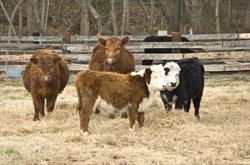Bob Judd, DVM, DABVP (Equine Medicine), DABVP (Canine and Feline Practice)
cows in a paddock

It is important to know how many bulls you need to service a certain number of cows.
According to Mark Johnson, OSU Extension Beef Cattle Breeding Specialist, the first goal of the breeding season is to get cows bred as quickly as possible early in the breeding season (drovers.com). This results in more calves being born early in the calving season next year and shorter breeding and calving seasons.
This means calves will be older when weaned and weigh more due to age, which makes them more profitable. The typical beef calf gains, on average, about two pounds per day until weaning, so a calf that is born from breeding on the first heat cycle versus the second cycle is approximately 21 days older and 40 pounds heavier.
To get these cows bred as quickly as possible, you need an adequate number of bulls that have been tested to be fertile. The age of the bulls plays a role in the number of bulls required per the number of cows. A 12 to 15-month-old bull should only be expected to breed 12 cows in a timely manner, while an 18-month-old bull should be able to breed up to 18 females, and a 24-month-old bull should be able to breed 25 females. Older bulls up to six years old should be able to breed up to 35 females.
For the first two years, a good guideline to follow is that the age of the bull in months is the number of cows that particular bull can breed in a timely manner, and a timely manner is important. Although a young bull could eventually get 40 cows bred, it would extend the breeding season, which is undesirable.
Another factor that plays a role in this is the bull’s fertility. Your veterinarian can check this and perform a fertility exam. Although a bull may pass a fertility exam, there are degrees of fertility, and knowing this could be important, especially in young bulls.